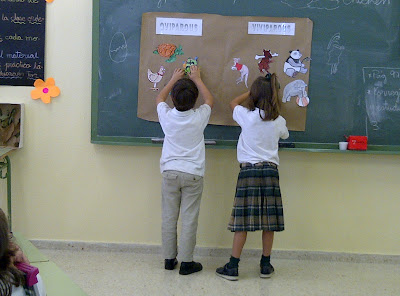The term CLIL refers to any activity "in which a foreign language is used as a tool in the learning of a non-language subject in which both language and the subject have a joint role" (Marsh 2002:58).
“CLIL refers to situations where subjects, or parts of subjects, are taught through a foreign
language with dual-focused aims, namely the learning of content, and the simultaneous learning of
a foreign language”.
“It [CLIL] provides exposure to the language without requiring extra time in the curriculum“.
(Marsh, D. 2002. Content and Language Integrated Learning: The European Dimension –
Actions, Trends and Foresight Potential).
But, after defining the term, we also have to pay attention to the process needed to do a good CLIL in class. As Do Coyle mentions in her article, there is a big danger, CLIL can become another version os TEFL or ESP. So, to prevent this from happening, we have to bear in mind that this kind of programmation can not be taught only by an English teacher (who doesn't dominate the contents of another subject) or by the specialist of another subject ( who doesn't know how to teach English).
As the author says, to integrate perfectly language and contents, the CLIL subject must be taught by the two teachers, the language one and the one who knows the contents. Only if the two combine their learning and design the lessons together, the CLIL lesson will have success.
To end this section of defining the term, it is very important to remember what is CLIL, but also that it is a very flexible practice, it can have very different curricular timetabling, it can be studied by very different ranges of ages, it can include projects or investigations, it can include chemistry practices,...etc. This can be better understood with this picture that I have found on the Internet:
As the author comments, research
shows that CLIL has some advantages for learners and teachers, it can: raise
learner linguistic competence and confidence; raises teacher and learner
expectations; develops risk-taking and problem-solving skills in the learners; increases vocabulary learning skills and grammatical awareness; motivates and
encourages students’ independence; it takes students beyond reductive foreign
language topics; it helps improving L1 literacy; it encourages spontaneity
on talking if students are enabled to learn through the language rather than in
the language; it develops study skills; generates positive attitudes and finally, puts cultural awareness back on the agenda.
Lots of schools in Europe are teaching CLIL units, but is not as easy as it seems...
Coyle has provided us with the 4c's framework to support CLIL pedagogy:
This framework, as we can see in the picture, focuses on the relationship between culture, communication, content and cognition, which means to integrate learning (content and cognition) with language learning (culture and communication).
To sum up this idea, we can say that we need to integrate learning to use language, and use language to learn. So it is necessary for CLIL to succeed, to take in account the 4C's carefully in the planning of the unit to be taught.
Learners are going to use and develop language TO/FOR/THROUGH learning, this is why teachers also must plan, monitor and evaluate CLIL learning and teaching from different perspectives.
This approach demands to analyze the role language plays in CLIL processes and engages providers in planning, monitoring and evaluating CLIL using a different set of criteria.
To finish this reflection it is important to bear in mind that as trainee teachers we should read all the principles on CLIL and also have the chance to practice CLIL methods in real contexts in order to be able to use this method in our future classrooms.
We have to keep on reading articles on CLIL to form our own idea of it. As future teachers we have to take in account that CLIL gives lots of advantages to our students because they are learning not only contents and not only a new language, they learn to use a language and also use the language to learn.








No hay comentarios:
Publicar un comentario